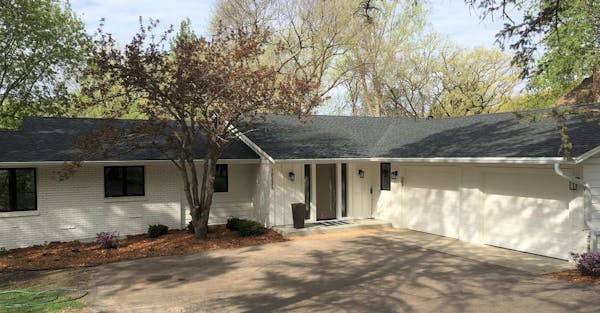The Walsh family's new cabin near Lutsen, Minn., is small — about 900 square feet — but it's just the right size for them and the way they enjoy being Up North.
"We wanted it to be like being nestled into nature," said Elizabeth Walsh of their cabin, which is tucked into a small clearing in the woods on the shore of Caribou Lake.
"Small was more affordable to build," said her husband, Daniel Walsh. "And we wanted to live in every inch, with no useless space. We wanted to relish the land as much as we could."
The Minnetonka couple and their daughter, now a young teen, have been heading north, to Lutsen or Grand Marais, for regular getaways for several years.
"We fell in love with the area," said Daniel.
Especially Caribou Lake, which is ringed by wooded bluffs.
"It's a very peaceful, very quiet lake," said Elizabeth. "You can kayak and be the only one on the lake."
For several years, they rented a place to stay. But they also like hiking with their two large dogs, a Newfoundland and a Samoyed, which complicated lodging arrangements, Daniel said. So they decided it was time to build a dog-friendly cabin of their own.
"We'll always have dogs," said Elizabeth.
The Walshes knew they wanted a modern-style getaway home.
"We both love modern architecture," said Daniel, who's particularly fond of the architecture of the Pacific Northwest, characterized by natural, exposed materials and connection to the outdoors.
On the Homes by Architects Tour a few years ago, the Walshes happened to go through the Stillwater home of architect Sara Imhoff, principal, Imprint Architecture & Design. Imhoff is from Seattle, licensed in Washington state, and had worked with a Seattle architect whose work Daniel had admired.
"We struck up a conversation, and it went from there," he said.
Imhoff, too, is a fan of Pacific Northwest-style architecture. "It has a formality but also is very grounded in nature, the way it sits on the land, with a low-slung roof or boxy look," she said.
Tight footprint
The building site the Walshes found had previously held a small older cabin, and their new cabin had to fit the same tight footprint.
That footprint posed a challenge, Imhoff said. "The lot is very large, but it is divided by the road, and half of it is rocky cliff hillside."
The little clearing where the earlier cabin had stood was "like a campground site, a trampled area," Imhoff said. "There was a natural swale around the flattened pad that allows water to drain from the hill to the lake."
The Walshes didn't want to clear any trees beyond the building site, Imhoff said. "They liked all the trees. They liked that campground wooded feel and the peekaboo views."
To accommodate those constraints, Imhoff designed a two-story cabin, 450 square feet on each floor. The rectangular shapes of the two floors are perpendicular to each other, with the two second-floor bedrooms partly cantilevered over the front entry and the porch.
"The bedrooms are not stacked above the living room space, which adds an additional privacy element for such a small cabin," Imhoff said.
She and Daniel spent a lot of time on siting the cabin to optimize light, flow and views of the lake, Imhoff said.
Durability and low maintenance also were high priorities, especially for the cabin's exterior.
The cabin is clad in corrugated metal siding, with one first-floor section sided in tight-knot cedar. "That part of the exterior is north-facing and low; it isn't going to take a huge beating from the sun," Imhoff said. "It's just an area to interject a little wood and warmth to the outside, while still keeping it low-maintenance."
Inside, the cabin features exposed beams of Douglas fir and floor-to-ceiling windows. "It's light and open to see the woodland trees and bring the outside in," Imhoff said.
The dog-friendly floor is polished concrete with radiant heat, while the staircase, doors and some other surfaces are plywood.
"I really like plywood," said Daniel. "It's really warm. I love the character of it. One of my favorite features is the plywood wall that slides to cover the mechanical room."
Standard plywood is rough, but the plywood in the cabin is of a higher grade, ACX plywood, that was sanded and sealed, Imhoff said. "People think plywood is cheap and easy. Actually, it's not. It was chosen for its modern quality, as opposed to knotty pine." It contributes warmth and durability, she added, and won't have to be repainted after the dogs rub against it.
"It's easy to keep clean and tidy," said Elizabeth of the cabin's low-fuss interior.
Long-distance logistics
Building a cabin that was 4½ hours away proved challenging, especially because there was no cellphone or Wi-Fi on site at the time of construction. Daniel would go up monthly to check on the project, but communicating with their builder between visits was complicated.
"Making sure you have good communication upfront becomes all the more important when you're not on the site," Elizabeth said.
Imhoff agreed. "Working from a distance was a challenge," she said. "I was very pleased with the way the cabin turned out, given the difficulty of communicating."
Because their cabin is so distant, the Walshes had expected to use it about four times a year and possibly rent it out on Airbnb the rest of the time. But once it was done, they discovered that they enjoy life at their cabin so much that they go up more frequently than they thought they would.
"We go every weekend until our daughter's tennis season starts," said Daniel. "We love to sit on the dock, to kayak, and to go hiking with our dogs."
They've come to appreciate northern Minnesota in all seasons. "We discovered snowshoeing this winter. It's a beautiful way to see the scenery," said Elizabeth.
And winter is cozy inside the cabin, with its wood-burning stove and walls of glass overlooking the snow-covered pine trees.
"We love it," said Daniel of their cabin. "It turned out just like we hoped."

Colm Toibin's 'Long Island' continues the Irish American story he began in 'Brooklyn'
Yuen: The bizarre and relatable case of Minnesota state Sen. Nicole Mitchell

